Art
MAN OF MANY ART-Sathar Al Karan
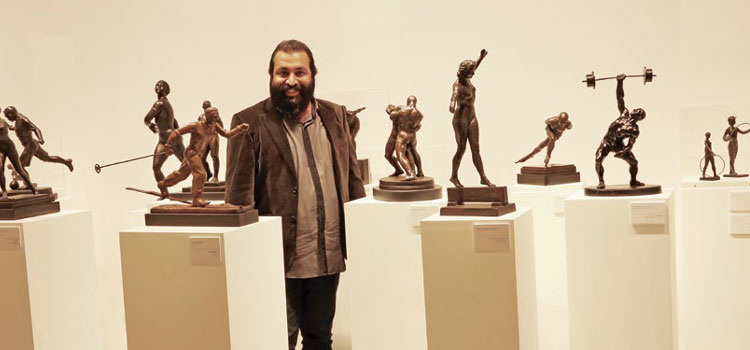
Founder of ART UAE and Yo.ae and co-founder of 1971 Events, Sathar’s entrepreneurial and eclectic spirit are incomparable
Words by Anca Mihaela Bruma Photographs by Harish Menon
Sathar Al Karan is a genius with many virtues. A business consultant, art exhibitor, and prestigious figure in the entertainment industry, he has over 20 years of experience advising media houses and representing Royal private offices as an investment advisor. Sathar has been recognised all over Dubai through events he has organised, like the Dubai Midnight Marathon, Dubai Art Exhibition, Emirates Awards and Global Luxury Council. We bring you poet and writer Anca Mihaela Bruma in conversation with the art maestro.
Please tell us more about your roles as an art curator and event organiser.
Sathar : It is a challenging process. But being open to creating dialogues rather than just being a keeper of talents is the fundamental key to success. I love art in different forms, and organising various events and promoting talents is one of its versions to me. I am interested in how poetic, evocative and intuitive art can be and how it can resonate within all of us. The most important thing is to come up with new approaches and options avoiding the barriers of conventional methods.
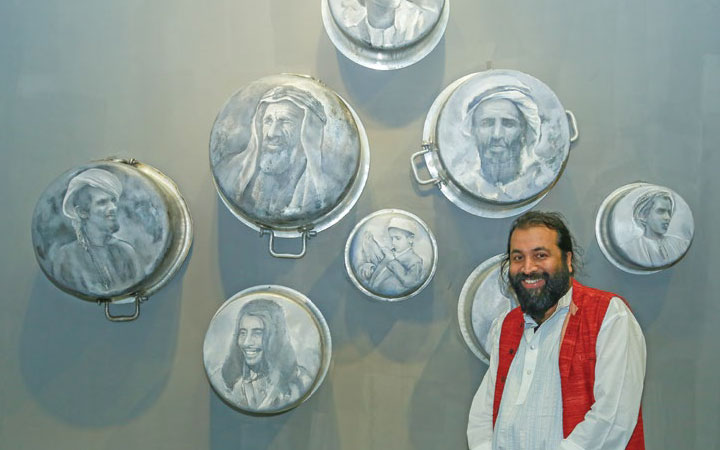
What do you feel makes your work unique and different?
Sathar : My style is adventurous and experimental. I was a creative soul since my childhood. My efforts are like testimonies to my approaches and how I bridge art, artists and society. To differentiate yourself in a very dynamic society, it is imperative to keep an open eye and to practice flexibility and understanding all the time.
You have been working with homegrown artists and expatriates. What is that like?
Sathar : In some projects, I am the custodian of a particular practice, style or method in the creative process. However, it is vital to be able to work in cooperation with everyone else, meeting at the intersection where our curiosities, skills and desires are triangulated.I believe in ‘the sensation of thinking’, a space where everyone-the organisers, artists and even the audience is given a space to feel and resonate, opening doors for conversations enabling them to embrace the full spectrum of possibilities latent in the work process.
The final outcome is important indeed, but the process is more crucial! Success is not instantaneous. It matters how you bridge various temporal rhythms of different generations and well nations. Everything is a dynamic process and each entrepreneurial activity shall be like an index of transformation. I personally enjoy the plurality of my roles, as an organiser of staged events, business consultant, curator of arts, and even photographer and poet. More like an ‘agent provocateur’(laughs). All these aspects have brought me a broader understanding and a unique empathy towards art.
You mentioned about plurality of your roles. What is more of you? A business consultant, curator of art, photographer, poet or IT specialist?
Sathar : All my “roles” belong together. And they are all a part of who I am. All these “roles” support me in my own experimentation and somehow differentiate me from the sheer density of my many competitors. They helped me create different contexts so as to be meaningful and accessible to the public, a groundbreaking approach with new ways of display.
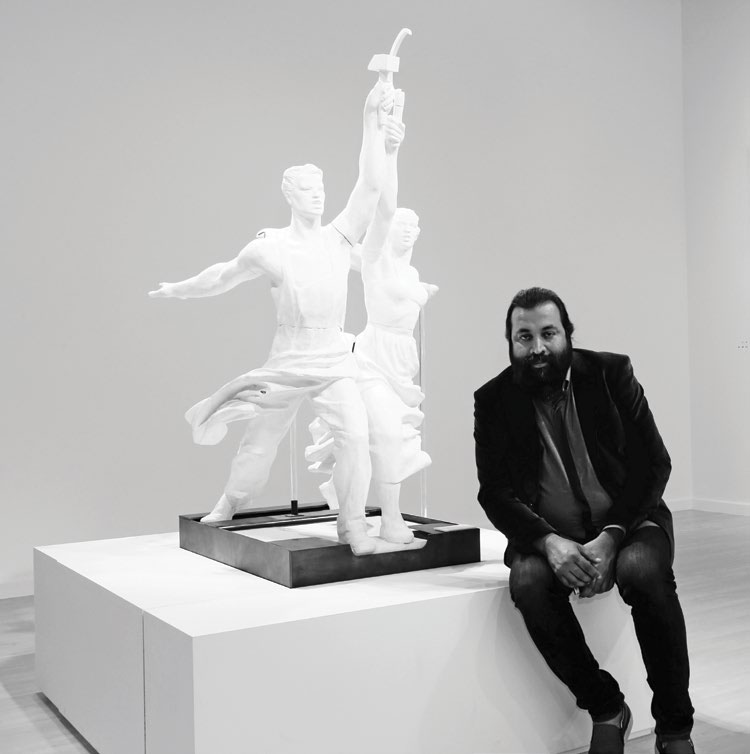
What is the most challenging part of your work?
Sathar : To remain creative! Anything I do, be it a business consultancy project, a website, a staged event or an exhibition, I infuse a special spirit into it.
Were you always interested in ART?
Sathar : Since I was a child, I had this predisposition towards creative expression. I was sculpturing then, contributing and volunteering at various art festivals back in India and of course sometimes expressing myself through poetry.
In a fast-paced world, do you see art emerging from the tech space?
Sathar : In the past decade, development of technology has had an impact on art, giving birth to new markets and new styles. Social media platforms play a vital role in promoting artists these days.
A little on your life in the UAE?
Sathar : Pretty challenging and provoking. I am married with three children and I have been living in the UAE for more than two decades now. I was young when I arrived here, full of ideas. Experiences taught me that life is a journey, a metamorphosis, and we all need to find the purpose and meaning of our own lives. I have found my own “voice” here. Developing a broad spectrum of skills, I have made a home of great support.
What will be your last piece of advice to the readers and lovers of art?
Sathar : Believe in yourself! Even if the whole world seems to not believe in you! Hold on tight to what you believe in! Challenges are inherently present during our span of life. While chasing our dreams, we need to be prepared to overcome hurdles. Know that our inner reservoir is endless. Be generous and learn to cultivate empathy!
Art
Navratri 2024: Celebrating the Nine Colours and Their Significance

Navratri, the festival that spans nine nights, is one of the most auspicious and widely celebrated festivals in India. Dedicated to the worship of Goddess Durga in her nine forms, each day of Navratri holds special significance, marked by a distinct color that carries deep spiritual and cultural meaning. As we prepare for Navratri 2024, let’s explore the nine colors associated with each day, their significance, and how they inspire devotion, positivity, and harmony.
Day 1: Yellow
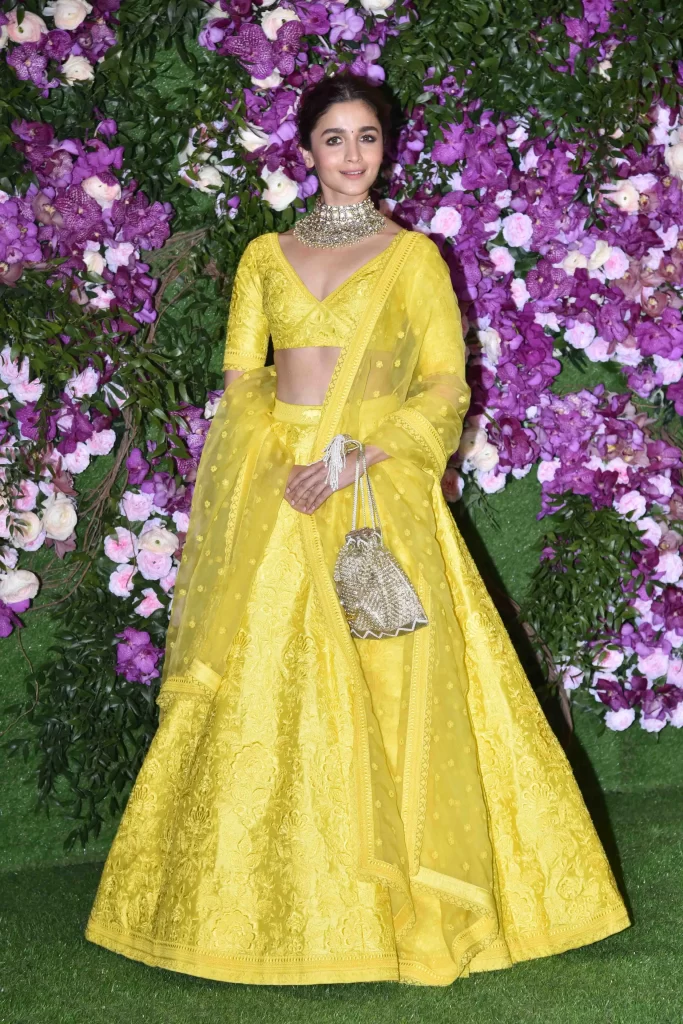
On Thursday, embrace the uplifting energy of yellow as you celebrate Navratri with optimism and joy. This warm and cheerful color symbolizes happiness and radiates positivity, keeping you in high spirits throughout the day.
Day 2: Green
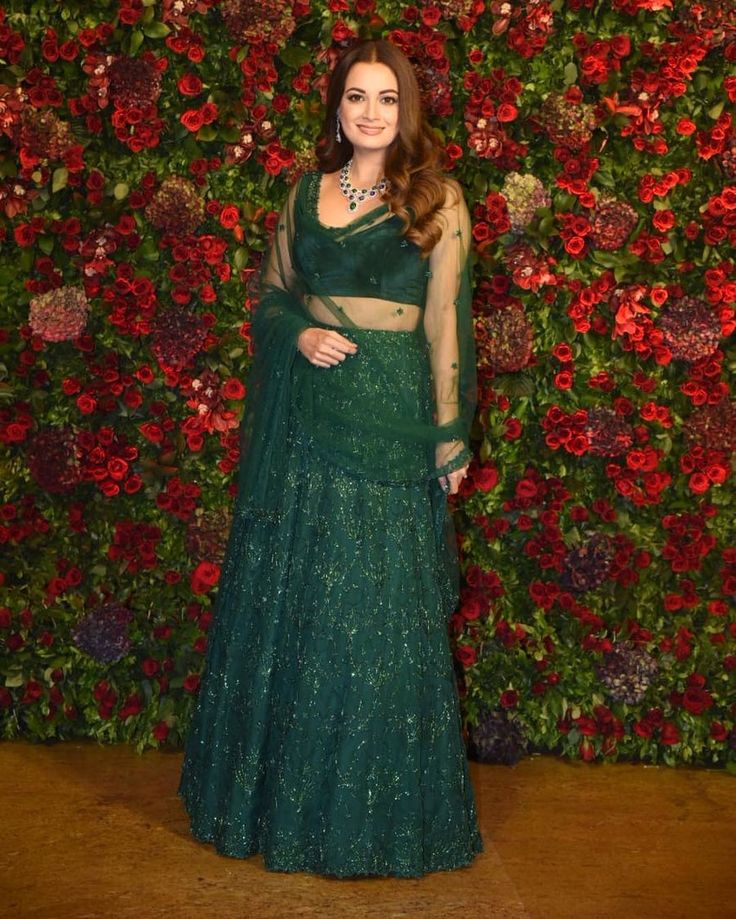
On Friday, wear green, a color that represents nature, growth, and harmony. It evokes a sense of peace and serenity, while also symbolizing new beginnings. Let the vibrant energy of green invite tranquility and the blessings of the Goddess into your life.
Day 3: Grey
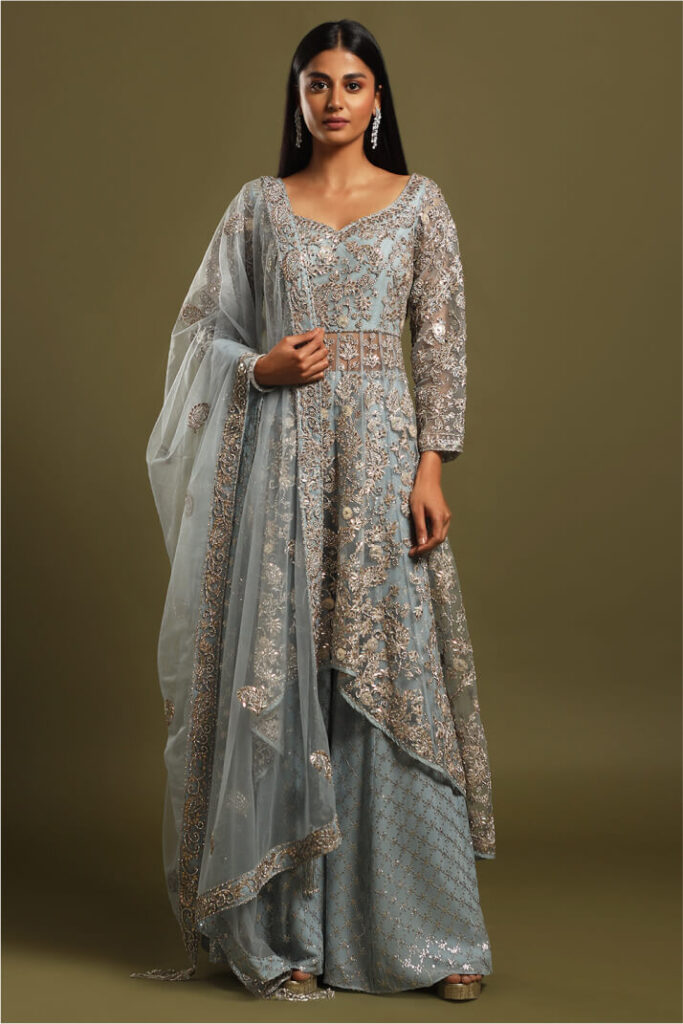
Saturday calls for the subtle sophistication of grey. This balanced color keeps you grounded and calm, symbolizing composure and understated elegance. It’s perfect for those who want to participate in Navratri with grace while making a refined style statement.
Day 4: Orange

On Sunday, adorn yourself in the vibrant hue of orange. This color embodies warmth, exuberance, and positivity. Wearing orange during Navratri invokes an upbeat energy, bringing vitality and a lively spirit to your celebrations.
Day 5: White

Start your Monday with the purity and serenity of white. Associated with innocence and spiritual clarity, this color invites inner peace and helps you connect with the divine blessings of the Goddess, offering a sense of security and calm.
Day 6: Red

On Tuesday, red takes center stage, symbolizing passion, love, and strength. As one of the most auspicious colors, red is often offered to the Goddess in the form of a Chunri. Wearing red fills you with energy, vigor, and the vibrant spirit of Navratri.
Day 7: Royal Blue

Wednesday’s color is royal blue, representing elegance, richness, and tranquility. This deep, vivid shade of blue exudes confidence and sophistication, making it an ideal choice for those who want to celebrate Navratri with style and grace.
Day 8: Pink

On Thursday, don the charming hue of pink, a symbol of universal love, affection, and harmony. Pink is a color that adds a soft touch of warmth and approachability, making it perfect for creating a loving and joyful atmosphere during the festivities.
Day 9: Purple

On the final day of Navratri, purple takes the spotlight. Associated with luxury, nobility, and grandeur, purple invites opulence into your life. Wearing this regal color while worshipping Navdurga bestows blessings of prosperity and richness, making it the perfect way to end your Navratri celebrations.
Art
Exploring the Rich Tapestry of Indian Art: A Journey Through State-Wise Traditional Paintings

India’s artistic heritage is a vibrant mosaic, reflecting the diverse cultural traditions of its states. Each region has its unique style of painting, with techniques and themes passed down through generations. Let’s delve into some of the most iconic traditional paintings from different states of India.
1. Madhubani Painting (Bihar)

Originating from the Mithila region of Bihar, Madhubani painting is known for its intricate patterns, bold colors, and themes inspired by nature, mythology, and folk tales. Traditionally, these paintings were done on mud walls, but now they are also created on cloth, handmade paper, and canvas.
Distinctive Features: Use of natural dyes, double outlines, geometrical patterns, and motifs like flowers, animals, and deities.
2. Pattachitra (Odisha and West Bengal)

umaid art
Pattachitra, meaning ‘cloth painting,’ is an ancient art form from Odisha and West Bengal. These paintings depict mythological narratives, especially around Lord Jagannath, and are characterized by their intricate details and mythological themes.
Distinctive Features: Fine detailing, elaborate borders, vibrant use of colors, and the use of natural ingredients for dyes.
3. Warli Art (Maharashtra)
Warli art is a form of tribal painting from Maharashtra, traditionally done by the Warli tribe. It primarily uses white pigment on a mud base to depict daily activities, such as farming, hunting, and dancing, in a minimalistic yet expressive manner.
Distinctive Features: Simple geometric shapes like circles, triangles, and squares, which represent different elements of nature and human life.
4. Tanjore Painting (Tamil Nadu)

Tanjore (or Thanjavur) paintings, originating from Tamil Nadu, are known for their rich colors, surface richness, compact composition, and use of gold foil. They often depict Hindu gods and goddesses, with a focus on Lord Krishna and other deities.
Distinctive Features: Use of vibrant colors, gold leaf, and inlay work with semi-precious stones on wooden boards.
5. Pichwai Painting (Rajasthan)

Pichwai paintings, hailing from Rajasthan, are intricate paintings that portray the life of Lord Krishna, especially in the Nathdwara temple. These paintings are traditionally done on cloth and used as wall hangings behind the deity in temples.
Distinctive Features: Detailed depiction of Lord Krishna’s life, use of bright colors, and the portrayal of various scenes from the Bhagavad Purana.
6. Phad Painting (Rajasthan)
Phad painting is a narrative scroll painting from Rajasthan, where the stories of folk deities like Pabuji and Devnarayan are depicted. The paintings are done on long pieces of cloth and are used in religious storytelling.
Distinctive Features: Bold lines, earthy colors, and the depiction of deities and their exploits.
7. Kalamkari (Andhra Pradesh)

Kalamkari, literally meaning ‘pen work,’ is an art form from Andhra Pradesh that involves hand-painting or block printing on fabric. The themes are largely mythological, with stories from the Ramayana and Mahabharata being common subjects.
Distinctive Features: Intricate handwork, natural dyes, and a distinctive color palette dominated by earthy tones.
8. Pithora Painting (Gujarat and Madhya Pradesh)

Pithora paintings, created by the Rathwa and Bhilala tribes of Gujarat and Madhya Pradesh, are done on the walls of their houses. These paintings are part of a ritual to invite the gods and ensure prosperity and happiness.
Distinctive Features: Vibrant colors, ritualistic significance, and the depiction of gods, animals, and scenes from daily life.
9. Chitrakathi Painting (Maharashtra)

Chitrakathi is a traditional art form from the Maharashtra-Karnataka border, where paintings are used as visual aids in storytelling. These paintings often accompany performances that narrate stories from epics like the Ramayana and Mahabharata.
Distinctive Features: Simple yet expressive figures, use of natural colors, and the narrative style.
10. Saura Art (Odisha)

Saura art is a form of mural painting by the Saura tribe of Odisha. It is similar to Warli art but has its unique elements, depicting the tribe’s daily activities, rituals, and deities.
Distinctive Features: Monochrome palette, linear style, and the depiction of nature and community life.
The diverse painting styles of India offer a glimpse into the country’s rich cultural heritage. Each state’s art form is a testament to the creativity and traditions that have been nurtured for centuries. By exploring these traditional paintings, we not only appreciate their beauty but also connect with the stories and values that have shaped India’s cultural landscape.
Art
The Microscopic Handbag Phenomenon: MSCHF’s Bold and Tiny Louis Vuitton Creation

In the realm of fashion, innovation knows no bounds, and the boundary-pushing collective known as MSCHF constantly proves this point. Their latest creation, a microscopic handbag inspired by Louis Vuitton, has taken the industry by storm, captivating fashion enthusiasts around the globe. Breaking free from traditional size constraints and redefining functionality, this miniature accessory has ignited curiosity and sparked a sensation. Join us as we delve into the extraordinary world of MSCHF’s microscopic handbag, exploring its origins, unique features, and the remarkable buzz it has generated.
MSCHF, renowned for their unconventional and thought-provoking projects, partnered with luxury fashion house Louis Vuitton to unleash a game-changing collaboration. Together, they birthed a surprising twist on the classic handbag, pushing the boundaries of scale to an entirely new level. The microscopic handbag challenges the norm and introduces an audacious new concept.

Measuring a mere 1.5 inches in height, the microscopic handbag is a masterpiece of miniaturization. This whimsical accessory captures the essence of a traditional Louis Vuitton purse, complete with the iconic monogram pattern and signature leather trim. Despite its minuscule size, it exudes luxury and craftsmanship, embodying the brand’s prestige and aesthetic.
The MSCHF microscopic handbag represents a captivating fusion of fashion and art. It blurs the lines between these creative realms and prompts us to question our perception of material possessions. Through this micro-sized wonder, MSCHF challenges our understanding of fashion’s role in society and invites us to contemplate the value we attach to material goods.
Since its introduction, the microscopic handbag has caused a viral sensation across social media platforms. Its diminutive size and unexpected collaboration have captivated fashion enthusiasts and sparked intriguing discussions. This extraordinary creation serves as a catalyst for conversations about fashion trends, the power of satire in design, and the evolving landscape of the industry. Once again, MSCHF has successfully captured the attention of the fashion world, pushing boundaries and reshaping our perception of what is considered fashionable.
MSCHF has cemented its legacy as a disruptive force in the fashion and art realms. Their innovative and thought-provoking projects consistently challenge norms and captivate audiences. With the microscopic handbag, they have once again showcased their ability to generate intrigue, spark conversations, and inspire wonder within the industry.
In conclusion, the MSCHF microscopic handbag stands as a testament to bold creativity and audacity in the world of fashion. Its tiny size and unexpected collaboration with Louis Vuitton have shattered conventional handbag design and ignited curiosity on a global scale. This extraordinary creation not only exemplifies the artistry and innovation of MSCHF but also invites us to reflect on the ever-evolving nature of fashion and its profound impact on our collective imagination. As we eagerly anticipate MSCHF’s next groundbreaking venture, one thing is certain: they will continue to redefine the boundaries of what is possible in the world of fashion.
-

 Style11 months ago
Style11 months agoBridal Guide : Best Looks of Radhika Merchant Ambani
-

 Fashion1 year ago
Fashion1 year agoMost Discussed Ajrakh Saree of Alia Bhatt
-

 Entertainment1 year ago
Entertainment1 year agoThe Most Stylish Guests of Bhagya Suresh Reception
-

 Entertainment1 year ago
Entertainment1 year agoBridal Bliss : All Bridal Looks of Swasika Vijay
-

 Movies1 year ago
Movies1 year agoA Nostalgic Journey Through Love &Cinema : Best Bollywood Romantic 90s Movies
-

 AD8 months ago
AD8 months agoPopular Curtain Fabrics to Consider for Your Home
-

 Fashion1 year ago
Fashion1 year agoMajor Denim Trends You Need To Know in 2024
-

 Events9 months ago
Events9 months agoBest of Fashion Looks : Diya Krishna Wedding





































